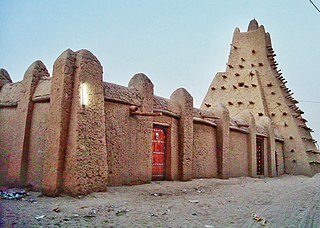 W
WThe Massina Empire was an early nineteenth-century Fulbe Jihad state centered in the Inner Niger Delta area of what is now the Mopti and Ségou Regions of Mali. Its capital was at Hamdullahi.
 W
WAhmad al-Bakkai al-Kunti was a West African Islamic and political leader. He was one of the last principal spokesmen in precolonial Western Sudan for an accommodationist stance towards the threatening Christian European presence, and even provided protection to Heinrich Barth from an attempted kidnapping by the ruler of Massina, Amadu III. In a letter to the ruler, which was rather a fatwa he denied the former's right to have Barth arrested or killed and his belongings confiscated, as the Christian was neither a dhimmi nor an enemy of Islam, but the native of a friendly country, that is Great Britain. He went as far as to deny Ahmad Ahmad ibn Muhammad Lobbo the right to proclaim a jihad and called him "the ruler over a few huts at the outskirts of the Islamic world".
 W
WDjenné is a town and an urban commune in the Inland Niger Delta region of central Mali. The town is the administrative centre of the Djenné Cercle, one of the eight subdivisions of the Mopti Region. The commune includes ten of the surrounding villages and in 2009 had a population of 32,944.
 W
WDjibo is a town in northern Burkina Faso. It is situated 203 kilometres (126 mi) north of Ouagadougou and 45 kilometres (28 mi) from the frontier with Mali. It was founded in the 16th century and became the capital of Djilgodji, before becoming dominated by the Massina Empire in the 19th century. It is known for its animal market. The main ethnic group are the Fulani. The spillway of Djibo Dam was the scene of a potentially catastrophic accident involving a cyanide laden truck en route to nearby Inata gold mine on the 29th of July 2011.
 W
WThe Great Mosque of Djenné is a large banco or adobe building that is considered by many architects to be one of the greatest achievements of the Sudano-Sahelian architectural style. The mosque is located in the city of Djenné, Mali, on the flood plain of the Bani River. The first mosque on the site was built around the 13th century, but the current structure dates from 1907. As well as being the centre of the community of Djenné, it is one of the most famous landmarks in Africa. Along with the "Old Towns of Djenné" it was designated a World Heritage Site by UNESCO in 1988.
 W
WHamdullahi was a nineteenth-century imamate in what is now the Mopti Region of Mali. Founded around 1820 by Seku Amadu, Hamdullahi served as the capital of the nineteenth-century Fula empire of Massina.
 W
WThe Inner Niger Delta, also known as the Macina or Masina, is the inland delta of the Niger River. It is an area of fluvial wetlands, lakes and floodplains in the semi-arid Sahel area of central Mali, just south of the Sahara desert.
 W
WMopti is a town and an urban commune in the Inner Niger Delta region of Mali. The town is the capital of the Mopti Cercle and the Mopti Region. Situated 630 km northeast of Bamako, the town lies at the confluence of the Niger and the Bani Rivers and is linked by an elevated causeway to the town of Sévaré. The urban commune, which includes both Mopti and Sévaré, had a population of 114,296 in the 2009 census.
 W
WMopti is the fifth administrative region of Mali, covering 79,017 km2. Its capital is the city of Mopti. During the 2012 Northern Mali conflict, the frontier between Southern Mali which is controlled by the central government and the rebel-held North ran through Mopti Region.
 W
WTimbuktu is a city in Mali, situated 20 km (12 mi) north of the Niger River. The town is the capital of the Timbuktu Region, one of the eight administrative regions of Mali. It had a population of 54,453 in the 2009 census.